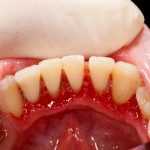
Smoking is an important risk factor for periodontal diseases with studies indicating that smokers have more severe periodontal disease and respond less well to treatment. However, while some studies suggest that smokers respond less favourable to periodontal therapy others find no significant difference between smokers and non-smokers.
The aim of the review was to evaluate the impact of smoking on clinical outcomes of non-surgical periodontal treatment.
Methods
Searches were conducted in the Medline/PubMed, Embase, Scopus and clinicaltrials.gov databases. Supplementary searches were conducted in the journals, Journal of periodontology, Journal of Clinical Periodontology, Journal of Periodontal Research, Journal of Dental Research. Randomised controlled trials (RCTs), case-control studies (CCs), prospective or retrospective cohort studies (CSs) including smoking and non-smoking groups of patients with periodontitis receiving only non-surgical periodontal therapy were considered.
Study quality was assessed independently by two reviewers using the Newcastle–Ottawa Scale (NOS) and the Oxford Centre for Evidence-based Medicine evidence levels. Data were independently extracted by two reviewers using a specially designed form, with accuracy being confirmed by a third reviewer. Pocket depth (PD) was the primary outcome measure, clinical attachment level (CAL) a secondary outcome. Weighted mean differences (WMD) and 95% confidence intervals (CI) were calculated and random effects meta-analysis conducted.
Results
- 17 studies (11 prospective and 6 retrospective CSs) involving a total of 948 patients were included.
- 15 studies defined the number of cigarettes smoked.
- Follow up times ranged from 1 – 12 months.
- 17 reported mean PD reduction and 12 reported on CAL gain.
- Meta-analysis (17 studies) showed a significantly lower PD reduction in the smoking group than the non-smoking group, WMD = −33 mm (95%CI: −0.49 to −0.17).
- Meta-analysis (12 studies) showed a significantly lower CAL gain in the smoking group than the non-smoking group, WMD = −20 mm (95%CI: −0.39 to −0.02).
- Subgroup analysis showed significantly lower PD reductions the smokers in studies under and over 3 months duration but only at over 3 months for CAL.
| Pocket Depth Reduction WMD (95%CI) | Clinical attachment gain WMD (95%CI) | |
| ≤3 months | −0.25 mm ( −0.54 to −0.04) | −0.33 mm ( −0.78 to 0.17) * |
| >3 months | −0.33 mm ( −0.49 to −0.17) | −0.16 mm ( −0.26 to −0.06) |
*Not significant
Conclusions
The authors concluded: –
…. smoking has significant negative effects on clinical outcomes of non-surgical periodontal therapy. Periodontitis in smokers has significantly less PD reduction and CAL gain than non-smokers within one year after treatment.
Comments
The reviewers have searched a number of major databases and relevant periodontology journals eventually including 17 studies. Eleven of the included studies were prospective cohorts and these are likely to have fewer biases than the other retrospective studies. Consequently, it would have been interesting to see what the impact on the outcomes would have been if only the prospective studies had been pooled. While the meta-analysis did demonstrate statistically significant smaller improvements in the smoking that non-smoking group any differences are modest and may not be clinically important.
Links
Primary Paper
Chang J, Meng HW, Lalla E, Lee CT. The impact of smoking on non-surgical periodontal therapy: A systematic review and meta-analysis. J Clin Periodontol. 2020 Oct 6. doi: 10.1111/jcpe.13384. Epub ahead of print. PMID: 33022758.
Other references
Dental Elf – 15th Nov 2019
Dental Elf – 8th Jul 2015
Dental Elf – 20th Jun 2014
Longitudinal study provides strong evidence that chronic smoking is a risk factor for periodontitis
